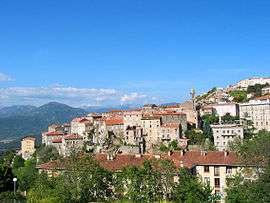Sartène
| Sartène | ||
|---|---|---|
|
A general view of Sartène | ||
| ||
 Sartène | ||
|
Location within Corsica region  Sartène | ||
| Coordinates: 41°37′18″N 8°58′27″E / 41.6217°N 8.9742°ECoordinates: 41°37′18″N 8°58′27″E / 41.6217°N 8.9742°E | ||
| Country | France | |
| Region | Corsica | |
| Department | Corse-du-Sud | |
| Arrondissement | Sartène | |
| Canton | Sartène | |
| Government | ||
| • Mayor (2008–2014) | Paul Quilichini | |
| Area1 | 200.4 km2 (77.4 sq mi) | |
| Population (2013)2 | 3,403 | |
| • Density | 17/km2 (44/sq mi) | |
| Time zone | CET (UTC+1) | |
| • Summer (DST) | CEST (UTC+2) | |
| INSEE/Postal code | 2A272 / 20100 | |
| Elevation |
0–1,320 m (0–4,331 ft) (avg. 330 m or 1,080 ft) | |
|
1 French Land Register data, which excludes lakes, ponds, glaciers > 1 km² (0.386 sq mi or 247 acres) and river estuaries. 2 Population without double counting: residents of multiple communes (e.g., students and military personnel) only counted once. | ||
Sartène (French: [saʁ.tɛn]; Corsican: Sartè Corsican pronunciation: [sarˈtɛ], Italian: Sartena), is a commune in the Corse-du-Sud department of France on the island of Corsica.
Its history dates back to medieval times and granite buildings from the early 16th century still line some of the streets. One of the main incidents in the town's history was an attack by pirates from Algiers in 1583, after which 400 people were taken away. These attacks continued into the 18th century.

The town is centred on the Place de la Liberation (previously the Place Porta), at the edge of which is the church of Sainte Marie. The town allows good views across the valley. Sartene wine is appreciated by wine connoisseurs for its good quality.
Sartene has given its name to one of the southern Corsican dialects that are most like the sardinian Gallurese dialect.
Population
| Historical population | ||
|---|---|---|
| Year | Pop. | ±% |
| 1800 | 1,882 | — |
| 1806 | 2,198 | +16.8% |
| 1821 | 2,200 | +0.1% |
| 1831 | 2,715 | +23.4% |
| 1836 | 2,682 | −1.2% |
| 1841 | 3,091 | +15.2% |
| 1846 | 3,892 | +25.9% |
| 1851 | 3,949 | +1.5% |
| 1856 | 3,874 | −1.9% |
| 1861 | 1,406 | −63.7% |
| 1866 | 4,082 | +190.3% |
| 1872 | 4,162 | +2.0% |
| 1876 | 4,724 | +13.5% |
| 1881 | 5,748 | +21.7% |
| 1886 | 5,608 | −2.4% |
| 1891 | 5,615 | +0.1% |
| 1896 | 6,154 | +9.6% |
| 1901 | 5,098 | −17.2% |
| 1906 | 4,378 | −14.1% |
| 1911 | 4,746 | +8.4% |
| 1921 | 6,135 | +29.3% |
| 1926 | 6,445 | +5.1% |
| 1931 | 6,479 | +0.5% |
| 1936 | 6,174 | −4.7% |
| 1946 | 5,592 | −9.4% |
| 1954 | 5,543 | −0.9% |
| 1962 | 2,805 | −49.4% |
| 1968 | 2,913 | +3.9% |
| 1975 | 3,761 | +29.1% |
| 1982 | 3,044 | −19.1% |
| 1990 | 3,525 | +15.8% |
| 1999 | 3,410 | −3.3% |
| 2008 | 3,135 | −8.1% |
| 2012 | 3,418 | +9.0% |
| 2013 | 3,403 | −0.4% |
Sights
Genoese towers in the commune of Sartène:
There are numerous archaeological sites in the commune or Sartène:
See also
References
External links
- A page on the history of the town
- Corsican Dolmens (English) (Italian)
| Wikimedia Commons has media related to Sartène. |

.svg.png)